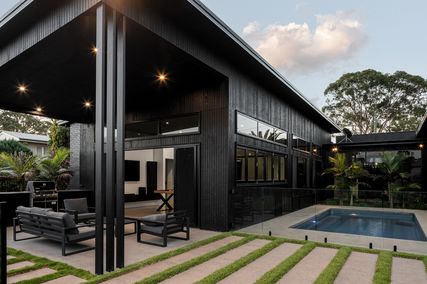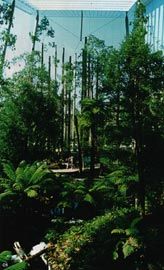
Forest Gallery, Melbourne Museum, by Taylor Cullity Lethlean. Image: Ben Wrigley.
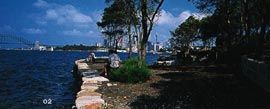
The old slipway at Longnose Point, Sydney, by Bruce Mackenzie and Associates. Image: Peter Bennetts.
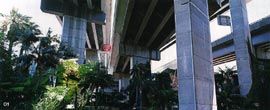
Darling Harbour. Cabbage tree palms under the Western Distributor. Image: Peter Bennetts
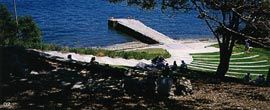
Amphitheatre and jetty at Burrogi Point, Sydney, by Craig Burton. Image: Peter Bennetts.
For Australian landscape architecture, the relationship between design projects and their indigenous setting has long been the most significant (and often, only) intellectual question. This preoccupation was best put by Bruce Mackenzie, one of the main innovators in the industry, in 1966 when he noted “a unique opportunity exists for achieving a cohesive and powerful theme for landscape design throughout this country by realising and promoting the potential of the indigenous environment”. Since that time, most celebrated landscape projects have attempted in some way to address this challenge. Harmony and appropriateness have become the twentieth-century Australian equivalent of “taste” in eighteenthcentury discourse on the Picturesque.
Catherin Bull’s recent book New Conversations with an Old Landscape brings together a range of projects that address this preoccupation. It is also the first major collection of Australian landscape architecture projects in book form – something that local landscape architecture culture has been waiting a long time for. This puts a tremendous pressure on the book: as the first of its kind it must be comprehensive, while also articulating its own curatorial intention of documenting projects with a very specific type of relationship to places.
Considering the significance of this book, Bull is undoubtedly the person to have written it. She is a major figure in the establishment of corporate landscape architecture practice in this country, notably through EBC (with Robin Edmond and Noel Corkery, which, much later, became the landscape section of Hassell). She has been an academic with UNSW, QUT and now holds the Dame Elisabeth Murdoch Chair of Landscape Architecture at the University of Melbourne. Bull is the academic as far as many landscape practitioners are concerned, and she has been both an active participant in, and a keen observer of, the development of landscape architecture in this country.
Beautifully illustrated with photographs by Peter Bennetts, the book documents a range of projects that engage with both specific places and general environmental notions.
Bull’s proposition that the “interplay between human use and natural process is fundamental to landscape quality” provides the rhetorical device of “the conversation” through which these projects are discussed, itself an interesting notion. Establishing the framework for the book, Bull asks if “Australians [are] capable of making and living with designed landscapes that respond more directly to the essential qualities of the places they inhabit” – a question that mirrors Mackenzie’s concerns 25 years earlier.
This framework suggests that there is an inherent trajectory or intention within the discipline. However, one might also broaden this conversation and consider other trajectories. For example, there is an evolving, increasingly rich body of work reflecting cosmopolitan and lateral responses to diverse sites, briefs and users that have nothing to do with Australia as an emblematic ideology. Nonetheless, this work is very Australian in approach – it is perhaps more about how we do things than what is actually done.
Interpretations of “Australian-ness” pervade the projects selected and seem to provide the content of the “conversations” Bull alludes to. Yet this is not directly discussed as a cultural phenomenon, instead the book privileges empirical ecological solutions. As a result, the projects often appear didactic rather than having the dynamic interplay that one would expect from a compelling dialogue.
When reading the book, it is sometimes difficult to balance the responsibility to cover the breadth of significant projects (incumbent on it as the first book of its type), with its environmental focus. For example, although projects that attempt to remediate or negotiate a zone between the urban and the bush are discussed, many important urban projects are missing because they do not fit the environmental agenda. Examples include the work of Ron Jones and the City of Melbourne, the building setting projects of Patterson + Pettus (now EDAW, Melbourne) and the civic design/public art collaborations of Oculus in Sydney. While these projects are not about the overt Australian-ness of the bush, they do cut directly to a conversation of why and how we choose to live in cities on the coast. This is not simply about the environment, but also about a rich cultural and social life. The urban projects are important as they are part of an interest in the idea of “the urban” that developed in the 1980s and 1990s. This provided a welcome tonic to the relentlessness of the bush for landscape architecture, in the same way that multiculturalism in provided a refuge from a pre-occupation with Australian-ness in the general culture. Indeed, there is something quite colonial about landscape architecture’s fascination with “the bush” – I get the sense that if we were comfortable in this country we would just get on and do stuff.
The language in which Bull conducts her conversation is broad and inclusive, suggesting that this book is a general audience as well as the industry itself.
Correspondingly, the book acts as advocate for, and exponent of, landscape architecture.
This means that while it articulates the discipline’s broad paradigms, it often ignores the internal discussions and disputes that have allowed the discipline to gain its relative contemporary richness. The most notable absence is a discussion of the role of design, which has consistently been sidelined to the environmental agenda.
Similarly, the book notes general, wellacknowledged international influences on the development of the country’s colonial landscape (such as the Picturesque) but it does not discuss contemporary influences from American Modernism. These influences have helped shape the conversations about conservation, outdoor living, site planning, as well as formal language and many of the projects covered, such as the freeway work at Darling Harbour, directly result from the influence of international key practitioners (Lawrence Halprin, in that case). However, this dimension of has been left out of Bull’s account in favour of an immaculate and self-contained local angle.
The conversation in American landscape architecture mirrors that in Australia. As colonial cousins, a cross-critique could enrich our understanding of what is unique about our approach, in the same way that comparisons between the Australian and American “Frontier” have been important in understanding our development history.
A consideration of these issues, combined with a discussion of the lineage and evolution of practices (the subject of Andrew Saniga’s forthcoming doctorate), would add much to our knowledge of the culture of Australian landscape architecture.
Like all historical documentation and discussion, each discussion of landscape architecture represents a threshold of sophistication upon which successive histories will build, until we develop a seriously rich and diverse understanding of our history. In fairness, any book that is the first of its type can never hit all the marks.
The existence of this book is a marvellous thing for Australian landscape architecture and others will be able to build on it. It documents, finally, some important projects, notably those of Bruce Mackenzie. However, 25 years on from Mackenzie’s challenge, it might be worth considering if it is still something we should be plagued by.
Source
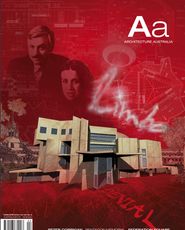
Archive
Published online: 1 Mar 2003
Words:
Julian Raxworthy
Issue
Architecture Australia, March 2003





